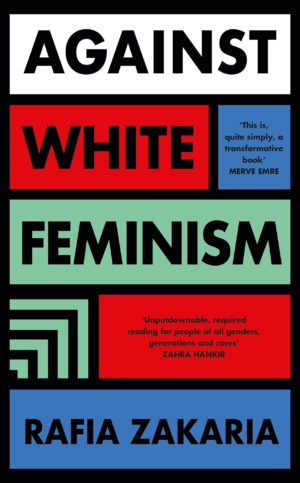You have no items in your cart. Want to get some nice things?
Go shopping
Studies show that roughly 1,500 women are murdered each year in the United States by an intimate partner, but when similar crimes are committed in a Muslim country, they are defined as “honour killings.” It is with this example that Rafia Zakaria most effectively explains how white feminism undermines the entire feminist movement in her Against White Feminism. By culturally coding crimes committed against women of colour, we fail to recognise the collective problem of male control and violence against women. Instead, we create a category of “other” that splinters efforts to achieve rights and protections for all women.
But this is only the first in a cascade of issues that not only further marginalise Black and Brown women, but also working-class women, minorities, and trans women, to name only a few.
In Against White Feminism, Zakaria’s razor-sharp focus on feminism details how white supremacy has negatively impacted women’s rights efforts for decades. She explains that colonialism allowed women to carve out a new place for themselves in society: They remained controlled by white men but viewed themselves as superior to the men and women in the countries they colonised. From here, she takes us through a history of feminist initiatives that have centred on white women. Anyone who has responsibly researched the history of white supremacy both in the United States and around the world will recognise the issues Zakaria raises in her book, but it is the detailed analysis of women’s issues that sets Against White Feminism apart.
Zakaria establishes her expertise with her own experiences as a single mother in the United States. Born and raised in Karachi, she moved to the US as a young bride and later fled to a domestic abuse shelter with her child. An attorney, she has supported victims of domestic abuse and seen firsthand the failures of the feminist movement. As early as law school, she experienced the dismissiveness of the men in charge (a dismissiveness with which all women are familiar), exacerbated by the fact that she is not white: “Even in the United States, I was one of a handful of single mothers in my cohort, insistent on graduating despite the admonishment of white course-load advisers who had told me that ‘law school was no place for mothers, especially not single mothers.’”
The book demonstrates that the greatest hurdle in the global effort to support women in poor countries is a lack of understanding and true political engagement with the issues at hand. Instead of learning about the problems women are facing and offering the help they need, many Western countries blindly offer solutions that do not apply or do nothing to support the political goals of women on the ground. She writes: “White and Western charity donors will eagerly donate money for girls’ education in Bangladesh for the uplift of women, but they will not give up the cheaply produced ‘fast fashion’ that is sold by major American brands and is based on exploiting women in poor countries. The implied goodness of the charitable act thus works to erase complicity in a global system that is instrumental in enforcing global racial hierarchies.”
And this need for “stuff” does not hurt only women in poor countries. Zakaria scaffolds her book with a timeline of feminists calling for change in the US, including Adrienne Rich, Gloria Steinem, and Eve Ensler, but explains how many efforts fell short. Kate Millett’s book Sexual Politics called for “radical political action….targeted toward dismantling the structures of capitalism that were similarly dominated by men.” Unfortunately, it appears Millett failed to persuade, and we see today how capitalism continues to put women at a disadvantage. Capitalism, or the “cash-happy Cosmo Girls interested largely in amassing power in the form of economic capital” won out over the radical feminists who were after real equality. Put simply, and depressingly: “Women could now choose among multiple brands of laundry detergent, but deferred or neglected opportunities to organise politically to demand free childcare for all women.”
The sex-positive movement, as well as “choice” feminism that removes all judgement from the choices women make, misses the mark because it doesn’t advocate for actual political change. Perhaps this failure is most clear when it comes to bodily autonomy and abortion rights.
Zakaria explains that when the British colonised India, there were lax abortion laws on the books in England. But due to the British belief that Indian women were sexually promiscuous, they created laws to curb the abortion they implied was a big problem in India. “Whether or not they may have been concerned with abortion in India itself, the white colonisers were clever enough to realise that painting Indians as inveterate baby killers was an ideal way to construct the colonised as criminal and hence to strip them of their humanity.”
Today, we see the same type of slander against women. In 2019, Donald Trump claimed that mothers and doctors were committing infanticide (a lie) and used this fiction to argue against abortion rights. Those who wish to restrict women’s rights capitalise on making the women dangerous and “other” in the same way the British did in India. While today’s restrictions in the US create hurdles for all women, we know they have an unequal impact on poor women and women of colour. Consider only the Hyde Amendment.
Many writers will say that the key to great writing is to have faith in the reader to grasp what isn’t said. Some of the examples Zakaria provides of white feminism – such as the sexist expectations of women in an office environment to be not too bossy or assertive – are all-to-relatable for any woman. So it is with these examples that Zakaria displays great faith in her reader to remain engaged. White readers could fall prey here to white fragility, but it is their engagement that can add strength to the feminist movement.
As Zakaria goes to pains to explain, there is a critical difference between “white feminists” (who “further entrench the race-based inequities in society and enshrines white culture”) and a feminist who is white. A true feminist will remain engaged in the feminist agenda while also rejecting “white feminism.”
Against White Feminism
By Rafia Zakaria
208 pages, Hamish Hamilton

About Monica Cardenas
Monica Cardenas is a writer living in the U.K. She holds a PhD in Creative Writing from Royal Holloway, University of London. Originally from Washington, D.C., she earned a BA in English from Wilkes University, Pennsylvania. Her novel-in-progress The Mother Law was longlisted for the Lucy Cavendish College Fiction Prize and runner-up in the Borough Press open submission competition. Her writing appears in Litro, Sad Girls Club Lit, and Catatonic Daughters.
- Web |
- More Posts(4)




